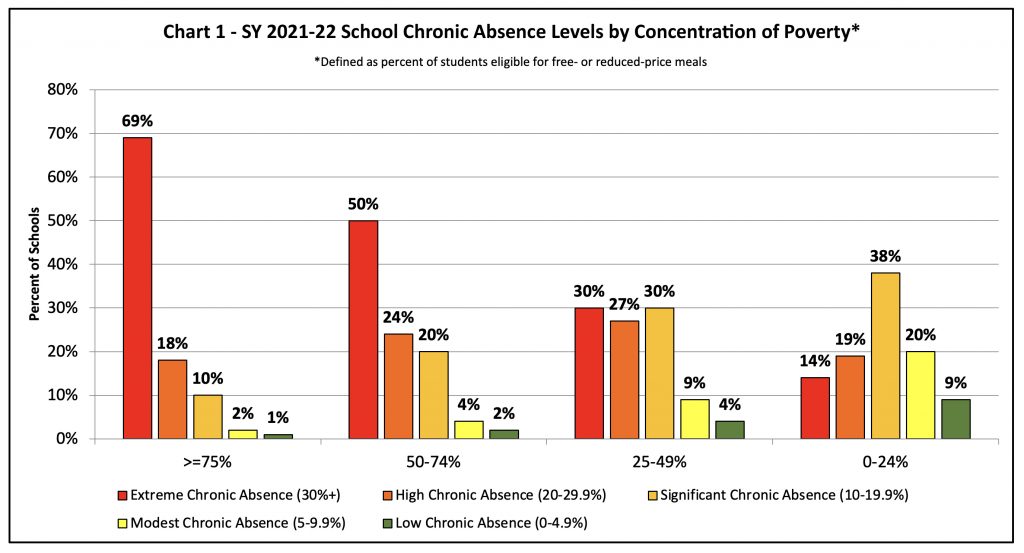
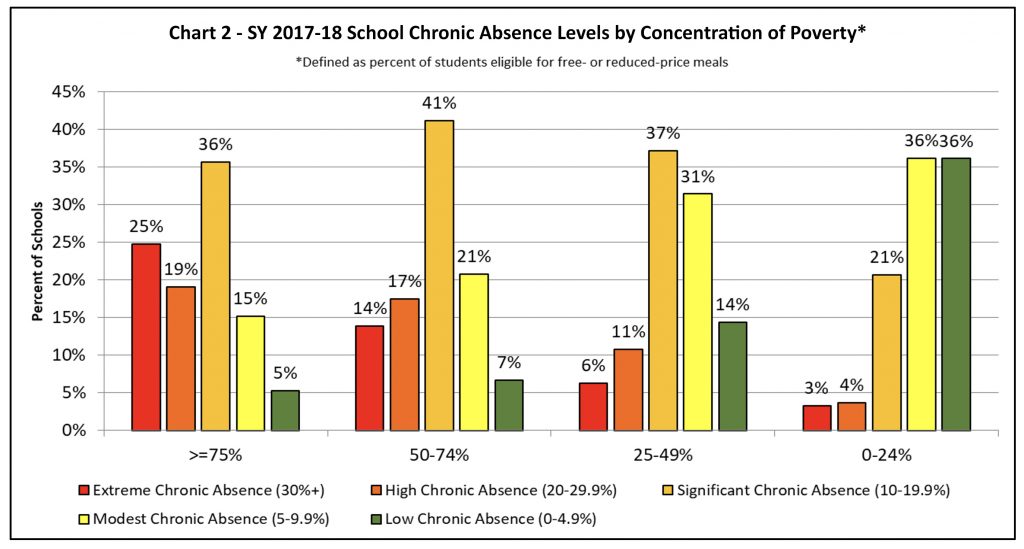
A new demographic analysis of 2021-22 school year chronic absence data from the U.S. Department of Education reveals that the pandemic-induced dramatic increase in chronic absence affects students from all backgrounds and localities and is widening inequities.
This analysis shows that districts, with support from states and community partners, must take a multi-pronged approach. Even greater efforts are needed in districts serving large proportions of economically challenged students.
In our first analysis Rising Tide of Chronic Absence Challenges Schools, we showed that in the 2021-22 school year chronic absence nearly doubled, rising from 16% before the pandemic to nearly 30% by 2021-22 school year. This means chronic absenteeism affected nearly 30% of students, or 14.7 million.
This attendance crisis has a broad impact on learning given that two-thirds (66%) of enrolled students attended a school with high or extreme levels of chronic absence. When chronic absence reaches high levels, the educational experience of peers, not just those frequently missing school, is also affected. National assessment data for 2022 show these increases in chronic absence are associated with significant declines in student achievement and threaten efforts to recover from the pandemic.
Chronic absence affects students of all backgrounds
Reducing chronic absence and increasing student engagement is in everyone’s interests. A deeper look into the 2021-22 data released through Ed Data Express, shows that chronic absence directly affects students from all backgrounds. (All figures are rounded to the nearest 100,000.) While approximately 5.3 million chronically absent students are found in cities, another 5.1 million are in suburbs. Nearly 2.6 million live in rural areas and 1.5 million live in towns. Click here to download national demographic data for the 2021-22 school year.
Chronic absenteeism also affects students of all ethnicities. In the 2021-22 school year, the largest number of chronically absent students were white (5.2 million), followed by Latino (5 million) and African American (2.9 million). Chronic absence is especially challenging for Pacific Islander and Native American students who experienced much higher rates even though their numbers are smaller. Chronic absence also affected large numbers of students with disabilities (2.7 million) and English learners (1.9 million).
Addressing the wide-spread absenteeism in the aftermath of the pandemic requires districts, supported by states, schools and communities, to take the lead in an all-hands approach. What works is developing consistent messaging across the community, re-establishing for families and students a connection to schools, and implementing a comprehensive array of proven attendance practices and interventions that addresses areas where students and families are struggling the most.
High levels of chronic absence in schools are widening gaps
At the same time, the unprecedented chronic absence in schools following the challenges created by the pandemic are deepening educational inequities. Students from populations that have historically had less access to equal opportunities to learn are much more likely to be enrolled in schools facing extreme levels of chronic absence. When this is the case, the educational experience of peers, not just chronically absent students, is affected by the constant churn of students in classrooms which affects both teaching and learning.
Poverty is a driving factor shaping the size and scale of the pandemic’s impact on a school’s chronic absence challenge. Between the 2017-18 and 2021-22 school years, the greatest increases in chronic absence occurred among schools serving higher portions of students experiencing poverty. Among schools with 75% or more of their students receiving free or reduced-price lunch (FRPL), schools with extreme chronic absence levels nearly tripled, from 25% to 69%. Among schools with 50% to 75% FRLP, it increased from 14% to 50%. (See charts 1 and 2.)
Click on each chart and table to enlarge.


Schools serving greater proportions of nonwhite students were similarly much more likely in 2021-22 to experience high and extreme levels of chronic absence than prior to the pandemic. This finding likely reflects an overlap with concentrations of poverty. (See charts 3 and 4.)
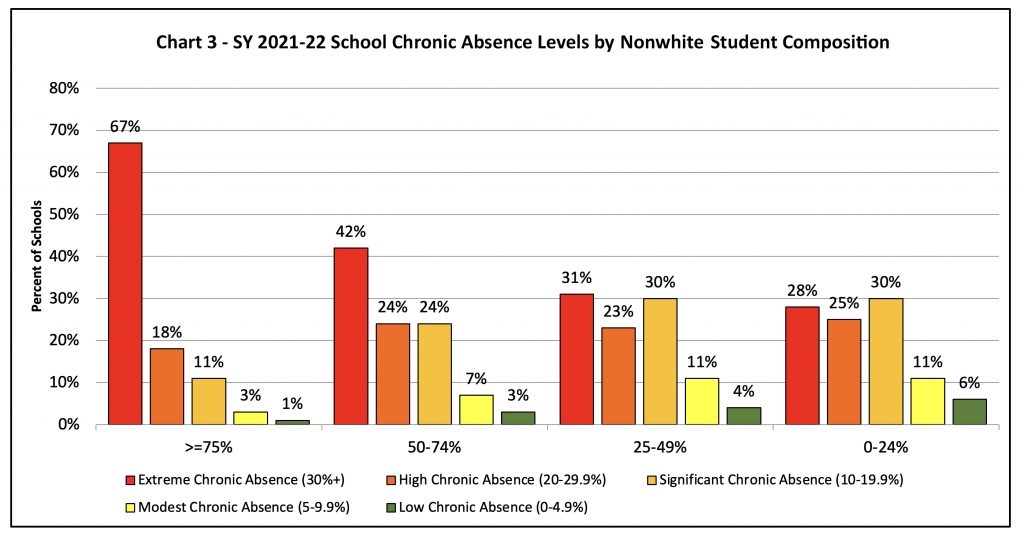
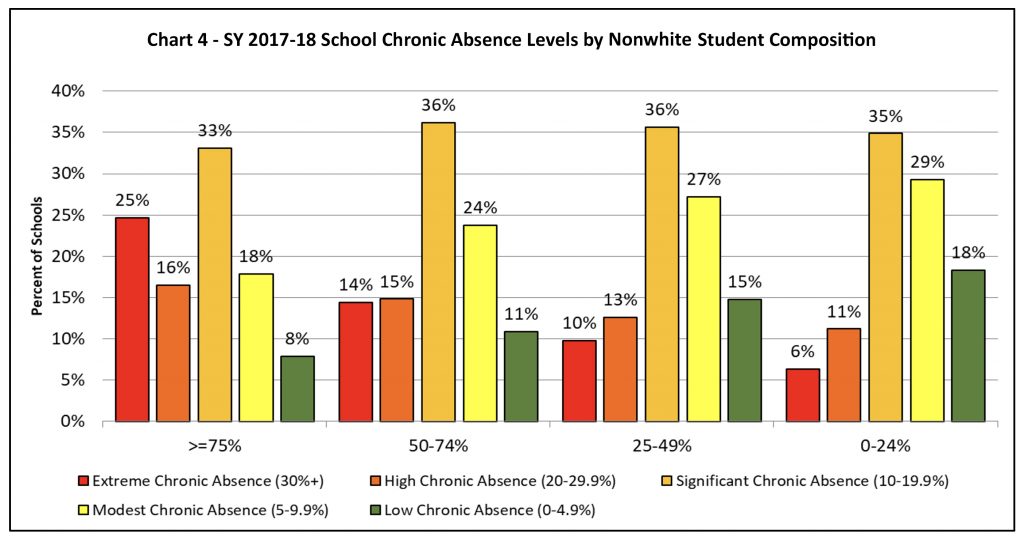
Districts are key to supporting schools
When districts serve multiple schools facing extreme levels of chronic absence, they must move forward with a system-wide approach. Districts should train teams to take a data-informed approach to engaging students and families and implement a coordinated set of tiered interventions. In 2021-22, about a third of all districts were faced with the harsh reality that more than half of their schools experienced extreme levels of chronic absence. (See district table.)
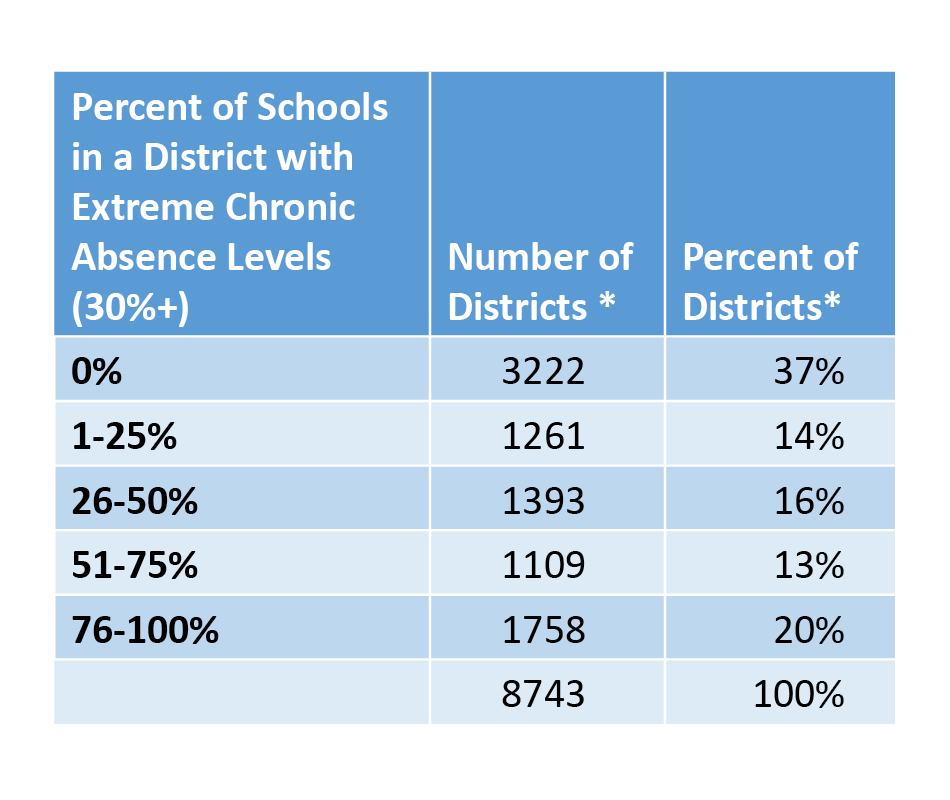
Districts experiencing higher concentrations of poverty face an even greater challenge. In almost half (41%) of the most economically challenged districts, the vast majority (75%) of their schools have extreme levels of chronic absence. In these districts, 75% or more of their students receive FRPL. By contrast, in the majority (65%) of more affluent districts, no school has an extreme level of chronic absence. In these districts, fewer than 25% of students receive FRPL.
An effective approach must also be tailored to local realities. For example, community organizations that can become potential partners are often more plentiful in urban or suburban areas than in more sparsely populated rural areas. On the other hand, rural areas may be able to leverage longstanding formal and informal relationships among staff at schools, local community members and other agencies.
An examination of data on school levels of chronic absence in 2021-22 suggests that urban areas are especially affected by the increase in the number of schools facing extreme chronic absence. In cities, 60% of schools now have extreme chronic absence, compared with only 23% before the pandemic. (See charts 5 and 6.) The larger the proportion of schools affected by chronic absence, the more important it will be to take a systemic and comprehensive tiered approach.
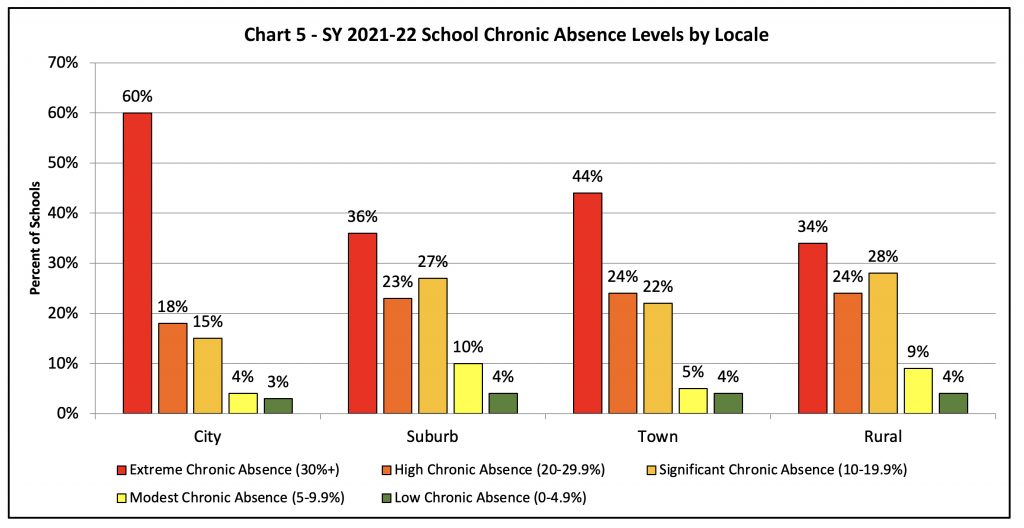
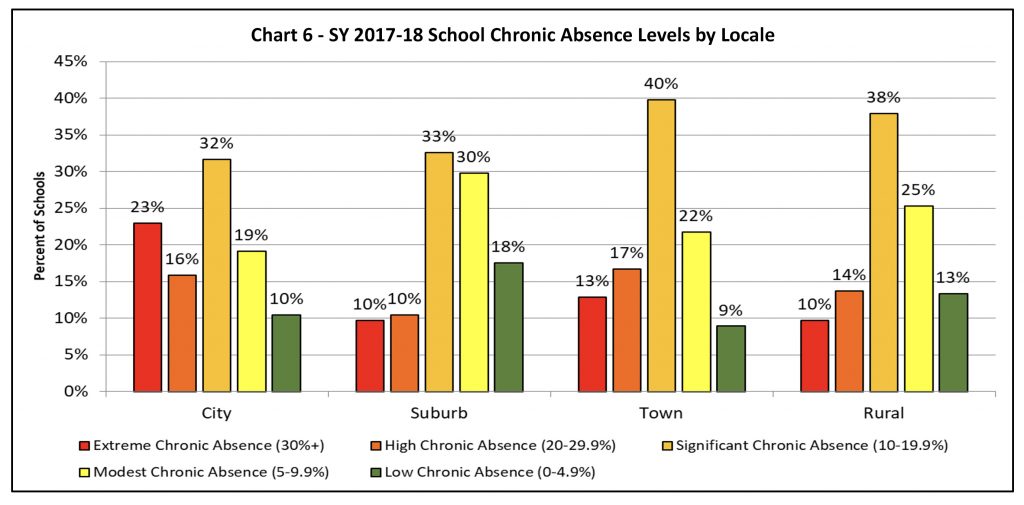
States can strengthen district capacity
States can use data to help determine how best to use their resources to build district capacity. Given that many more schools and districts than ever before now serve chronically absent students, states should provide all districts with a basic level of guidance and resources around improving attendance while also offering more intensive technical assistance or comprehensive initiatives (like community schools) to districts with higher levels of chronic absenteeism. States can also create peer learning opportunities for districts and schools, especially with those with comparatively better results to enable them to share their strategies. Such resources can be built into a state’s overall approach and resources for school improvement. Connecticut is an excellent example of how a state can offer multiple levels of support.
When determining who needs a higher level of assistance, states can examine which districts have multiple schools with high or extreme levels of chronic absence as well as determine where chronically absent students are concentrated.
A systemic, multi-pronged district approach is needed to improve attendance
Although these numbers are challenging, the current high tide of absenteeism can be reduced. When districts, with state support, develop approaches to improve attendance, they can draw on numerous strategies that have been proven to work, especially when they organize everyone including public agencies and community organizations to address the root causes of absenteeism and reflect current needs. Key to motivating attendance is re-engaging students and families, listening to their challenges and working as partners to identify and create solutions for attendance barriers. The strategies outlined below are especially important at this moment in time:
When chronic absence affects large numbers of students, it is not just one strategy at one school or district that makes a difference; it’s the weaving together of multiple strategies into a coordinated comprehensive approach. Attendance improves when districts can ensure schools are able to create teams that adopt and sustain a multi-tiered system of support. This tiered approach should start with prevention and intervention and investing in positive conditions of learning as the foundation. Student Success Systems, the next generation or early warning/on-track systems, can also provide a means for schools to monitor all students for chronic absenteeism and enable schools to respond when students show the first signs that they are heading towards becoming chronically absent.
Districts are already seeing reductions
The good news is that districts that have adopted comprehensive approaches that emphasize authentic partnerships with students and families are beginning to see notable reductions. In our recent Attendance Awareness Campaign webinars we have featured locations where there is excellent work underway, for example in:
While elevated levels of chronic absence will not be eliminated overnight, districts are well positioned to re-engage students and ensure an equal opportunity to learn when they invest, over time, in a data-informed, all-hands-on-deck approach to improve attendance.
This analysis is the second in a three-part series of articles unpacking the recent chronic absence data collection released by the U.S. Department of Education for the 2021-22 school year. Read part one, Rising Tide of Chronic Absence Challenges Schools, and part three Turning Back the Tide: The Critical Role of States In Reducing Chronic Absenteeism.